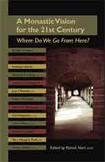A Lifestyle in Trouble?'
In his Introduction, Dom Bernardo Olivera, O.C.S.O., warns that if monastic life is not continually updated, it is going to have very little to say to generations of the future. Terrence Kardong, O.S.B., is distressed by the shrinking number of applicants to monastic congregations. His own, the largest in the Benedictine male world, today has about half as many members as in 1965, since it seems that only in developing countries are monasteries finding recruits.
And Kathleen Norris, a best-selling author of reflections on the spiritual life, fears that retreatssometimes the only dependable source of a monastery’s incomemay in time become just one more commodity for a public ever greedy for new fashions in prayer beads, votive candles or meditation techniques.
But most of the essays are optimistic. For the always formidable Joan Chittister, O.S.B., the years immediately ahead are as significant as any of the other crossover points in history, when monasticism captured the religious imagination. She strongly believes that only religion can possibly stop the violence being used in its name.
Nevertheless she wonders whether feeling complacently assured of eternal institutional life is living in myth or reality. Renewal, she writes, requires the emotional maturity and the living faith to believe that the vision that spawned it lives on even after the structures which expressed it are in need of replacement. She cautions against the ever present danger of turning to religion as a way of escaping the anxieties of the world around us. The purpose of prayer in a monastic community, she stresses, is not simply to say it; it is to be shaped and formed by it, excited and troubled by it, challenged and confronted by it in those empty spaces in our own lives where the voice of God is yet to be heard.
John Eudes Bamberger, O.C.S.O., urges a whole new version of monastic life. As a prominent element in our society the new data supplied by the physical and biological sciences should be included in monastic teaching, he writes, insofar as it bears on the life of prayer and contemplation as well as on moral and dogmatic theology.
The Rev. Daniel P. Coughlin, chaplain of the House of Representatives, shares the profound effect his many stays at monasteries have had on his ministry, including a refreshingly simple description of his own technique of meditation. His recounting of the soul-wrenching experience of having to compose a prayer for the session of the House that followed Sept. 11, 2001, is particularly impressive. (It was one more situation, he says, in which his bond with the Cistercian monks gave him the power to respond effectively.)
In focusing on Enclosure, the Heart of the Matter, Abbess Gail Fitzpatrick, O.C.S.O., points out that the various ways contemplatives make use of the call to solitude is not limited to those in the religious life. She recalls the testimony of a married woman who prays at her abbey: I am trying to pay more attention to the sacramental nature of my marriage and the way it functions as a source of grace in my life.... [E]nclosure is an important issue in my marriage and it involves trying to honor and respect those parts of each other we have no right to intrude upon. Of a married couple, the abbess notes with approval that their sacred space is their car as they drive to work together.
While having no vocation to any strictly contemplative community, the Protestant theological writer Bonnie Thurston credits her stays at the Anglican convent of All Saints’ Sisters of the Poor with shaping her life. She takes St. Benedict’s concept of the Rulechoosing that to which we will be obedient, to which we will listenvery seriously indeed, and regards her writing as the means by which her whole person hears God.
But she also recognizes that the transitional period in which monasteries are finding themselves is cause for concern and suggests that such times call for both loyalists and loyal opposition.
The most unusual chapter in A Monastic Vision for the 21st Century is a short play by Mary Margaret Funk, O.S.B., in which Abbess Brigid, from a contemplative order in Ireland, visits a second abbess in her Michigan monastery. Though charmed by the signs all over the monastery that read Silence spoken here, Abbess Brigid is soon engaging in friendly arguments with Abbess Gertrude about various aspects of the contemplative life, like the balance of solitude and communityalone together, or together alone?the importance of silence in their lives and whether a monastery should be a place for mystics or for ordinary people leading ordinary lives. While the playlet may never be nominated for a Tony Award, it is amusing and touching and provides fresh insights on the life of prayer.
Thomas Merton’s ideas permeate this compilation, as contributors frequently cite the renowned Trappist monk. Readers who, like them, are far from ready to pull down the curtains on monastic life will be pleased to find these pages filled with new seeds of contemplation.
This article also appeared in print, under the headline “A Lifestyle in Trouble?',” in the May 14, 2007, issue.








